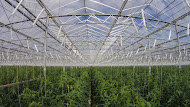Secret of Australian desert farms
This incredible farm makes tomato plants bloom in the desert using nothing more than sunlight and seawater. Needing no soil, fossil fuels, groundwater, or pesticides, and using coconut products on behalf of soil. Sundrop Farms grows crops in a hydroponic greenhouse lined with water-drenched cardboard. The 20-hectare farm officially opened on October 6th near Port Augusta, and their desert-grown tomatoes are already for sale in Australian grocery stores.
Sundrop Farms works agricultural magic. Conventional farming
won't work in the desert region, but that doesn't matter for this desert farm.
It obtains water from the Spencer Gulf and desalinizes the water using
renewable energy. 23,000 mirrors reflect light to a receiver tower to generate
solar power. When the sun is shining, the system can provide 39 megawatts of
clean energy – that's enough to keep the desalination plant working and power
the greenhouse, which is heated during the winter.
 |
| Cocopeat Grow Bag |
The facility can grow 17,000 metric tons of produce
each year. 18,000 tomato plants grow in the greenhouse, and Sundrop Farms aims
to grow other crops like fruit and peppers. The reason behind such a largest harvest is because of coconut
derivatives with specially cocopeat. The
reason for large harvest is befalls due to usage of coconut derivatives like
coco peats instead of soil that do not consist any pests existed in soil.
With an increasing awareness of environmental
sustainability and eco-friendly agriculture methods, we are investing in
eco-friendly horticulture practices. and using predatory insects to control
pests that could harm plants.
The farming system cost $200 million to build – but
Sundrop Farms CEO Philipp Saumweber says the hefty price tag will pay off over
time because the farm won't need to purchase any fossil fuels. The farm can
hook up to the grid if there are winter solar power shortages, however, its
ultimate goal is to progress to the point where it's completely self-sufficient.
According to Sundrop Farms, "we are breaking
farming's dependence on finite resources." This year they broke ground on
a farm in Tennessee, and they recently finished their first European farm in
Portugal.






Comments
Post a Comment